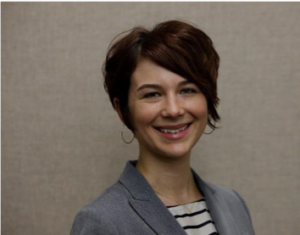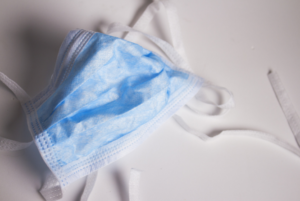Thanks to the coronavirus pandemic, we’re dealing with a new normal. Many of us are working from home, helping children with their schoolwork, and consciously following safety rules and procedures. While our worlds have undoubtedly been turned upside down, we can’t forget that many of our neighbors are facing severe obstacles; they don’t have enough money for food and bills, and might even be fighting COVID-19 symptoms.
This week, Becca Carpenter and a local Madison nurse practitioner (who preferred to remain anonymous) share their experiences of coping with the impacts of the virus. Becca provides crisis communications expertise at The River Food Pantry, while the nursing manager deals with unique communication and safety challenges caused by the pandemic.
Becca Carpenter, Communications Manager, The River Food Pantry

Ever since I heard those words from my employer four weeks ago, I’ve had a different perspective on my work. I have the privilege of keeping our community informed on how The River Food Pantry is responding to the coronavirus pandemic and how you can help.
Like many of you, I’ve recently faced a steady stream of unfamiliar communications challenges, including postponing a significant event, digitizing manual processes, and developing an emergency fund campaign. We’ve also had to meet tight deadlines for COVID-19 funding grants.
I’ve made it this far thanks to The River’s extremely supportive team. Whether working at The River or at home like me, my coworkers have stepped up to the challenge. They’ve collected so much content—including videos, photos, stories and statistics — that I get to share across multiple platforms. Plus, everyone has been super responsive via text, email, calls, and Zoom conferences.
With support from my team and a passion for making a difference, I will continue to serve as a lifeline to connect our audiences—clients, volunteers, donors, and community partners—with the essential information they need during this difficult time.
How is The River responding to COVID-19?
We’ve adapted our services to meet the growing nutritional needs of food-insecure households in Dane County for the duration of the pandemic. We’ve placed our hot meal and clothing programs on hold. But we’ve increased our hours of distribution while meeting an increased demand for emergency food and supplies.
We’ve also established The River’s COVID-19 Emergency Food Fund to provide:
- Boxes of groceries, including perishable and non-perishable foods, for hundreds of local households to pick up curbside at The River once a week.
- Pre-bagged lunches for children delivered six days a week through MUNCH, The River’s mobile lunch program, to nine low-income Northside neighborhoods.
Since March 16, The River has served:
- An average of 90 pounds of emergency food and supplies to each household per visit.
- A total of 1,710 unique households, including 437 new registrations.
- An average of 200 MUNCH lunches per day to children in need of nutritional assistance.
As the demand continues to increase, so does the community support. So far, over 1,000 donors—many of which are new—have given more than $250,000 to our COVID-19 Emergency Food Fund. On top of that, we’re seeing some of our best Facebook engagement rates ever!
How can you help?
Please visit www.riverfoodpantry.org/covid-19-updates to sign up to volunteer (if you are healthy and under age 60) and to support The River’s COVID-19 Emergency Food Fund. By supporting this fund, you help the most vulnerable members of our community receive the resources they need during this challenging time.
Madison Nurse Practitioner, Anonymous

Working in medicine during this unprecedented time is like nothing we have ever seen before. Previously, we worked to bring people together. We went to patients’ homes to treat them, brought people together for information or support, and helped families at the time of a loved one’s death.
Now, we are doing what we can to keep people apart. While we are doing this for the health and safety of the population at large, it wreaks havoc on the mental health of patients and providers alike. Although Wisconsin has not been hit with COVID-19 to the same degree as New York, we are still preparing and doing what we can.
I am in a “well clinic.” Patients with any symptoms are sent away. However, we are still required to wear personal protective equipment. We put on masks when we’re within six feet of coworkers and masks and face shields when we’re with a patient. We are currently out of surgical masks, and I’ve been wearing the same N95 for several weeks. Frankly, it’s gross.
Diagnosing Off-Site Patients
Previously, our typical patient load was 18-20 patients per day. Now that we have removed all non-essential visits and are doing everything we can via the phone, we typically see six to eight patients, and only one or two are in person.
It’s hard to assess and diagnose patients over the phone. As medical professionals, we have been trained to use all our senses to diagnose conditions. All but one of those senses has been taken away from us. Patients still want answers, medications and treatments even though our diagnostic resources are greatly diminished.
How We Can Assist
AMA members can help by following the Safer at Home guidelines and reminding others to do the same. We need to remind people that as much as this stinks, it IS working! I’ve gone back and forth on what I think we should be doing. Still, I’m constantly reassured by the daily numbers. I know that my ICU colleagues can manage their current number of patients.
I just saw a Facebook post today that made a great analogy. If we reverse the Safer at Home order now, it’s as though we are saying, “the parachute has slowed my descent so I can take it off now!”
Teens and young 20-somethings, especially, tend to think they are invincible. If there is any way to help them understand that they also need to stay home, you would be performing a great service. For teens and young adults, their risk of getting extremely sick is low, but their risk of asymptomatic transmission could still be high.
Share videos that explain issues like indirect transfer. Gloves don’t do anything if you aren’t washing your hands and keeping your personal possessions clean and safe.
Keep Sharing
The greatest thing I have learned in all of this is the value of communication. Not only do we have to hone our listening skills and medical history taking, but we need to listen to each other. Listen for the stress that we are all sharing. Commiserate together but do it via the phone or video chats.
Colleagues are working closer and collaborating more than ever because we have the time to make these connections. But now, we must figure out how to coordinate efforts from across the clinic instead of next to each other. We are consulting over the phone and via text. Sometimes we use video chats so that we can see a face!
We aren’t seeing as many people face to face, so it makes those connections harder. It’s not easy to read facial expressions beneath a mask, either. I keep getting upset that my colleagues can’t tell that I’m smiling at them when we pass in the hallway.
Trying to maintain our spirits is harder and harder. Many of us are working in places without windows. Without sunshine. As a result, the midday walks are more critical than ever.
Hopefully, when spring finally joins us for good, spirits will change. Until then, we need to find ways to lift each other up … from afar. This is something I am still learning how to do. I don’t think I have it down quite yet.
